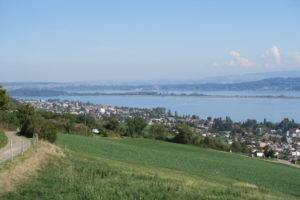Swiss Canals and Dykes
21 September 2020
Swiss engineers can not only build tunnels and railways but also dig canals and build dykes.
Le Grand-Marais is the region in the Three-Lakes Land (Drei-Seen-Land/le Pays des Trois-Lacs) lakes of Neuchâtel (Neuenburg), Bienne (Biel) and Morat (Murten) and stretches across the cantons of Bern, Freiburg, Solothurn, Waadt and Neuchâtel.
In the last ice age, there was a large lake over 100 kilometres long, stretching from Yverdon-les-Bains to Solothurn. The rivers Aare and Thielle crossed this region and caused many floods.
It was not until the second half of the nineteenth century that it became technically possible to regulate these rivers (and the Seyon near Neuchâtel) by water management, the Jura Water Correction (La Correction des Eaux du Jura/Juragewässerkorrektion).
The project took place in two stages. The first from 1868-1891. The Aare was diverted into Lake Bienne by digging a canal between Aarberg and Hagneck.
Three other canals are: between Lake Morat and Lake Neuchâtel the channel of la Broye, between Lake Bienne and Lake Neuchâtel the canal of Thielle and the canal between Nidau-Büren.
One of the first hydroelectric works, the BKW (Bernische Kraftwerke), was built in Hagneck in 1900.
The water level of the lakes dropped almost three metres. This development created new agricultural, natural and recreational areas.
The island of St. Pierre, the residence of Jean-Jacques Rousseau (1712-1778) in 1765 became a peninsula.
The water flooded the fruit and vegetable barns of Seeland again in 1954 and 1955. The answer was the second stage of the Jura Water Correction: dikes were built and/or raised near Epsemos and Hagneck between 1962 and 1973.
Nature, humankind and culture can go hand in hand, as this project in the Three Lakes Land shows.
Today, the area is under the protection of the Fondation suisse pour la protection et l’aménagement du paysage/stiftung Landschaftsschutz Schweiz.

